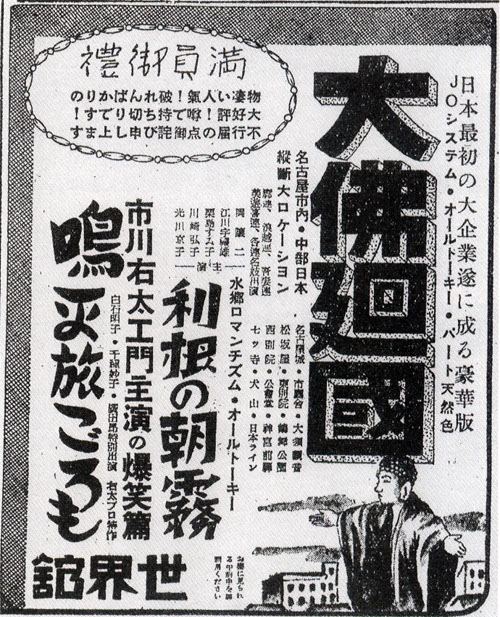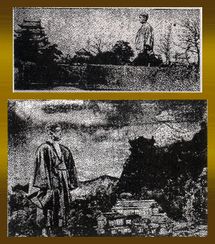Daibutsu Kaikoku (lost Japanese kaiju film; 1934): Difference between revisions
No edit summary |
(Added Lost box, fixed grammar and formatting) |
||
| Line 1: | Line 1: | ||
{{InfoboxLost | |||
|title=<center>Daibatsu Kaikoku</center> | |||
|image=Giant buddha.jpg | |||
|imagecaption=Japanese film poster. | |||
|status=<span style="color:red;">'''Lost'''</span> | |||
}} | |||
Also known under it's longer, translated title of ''The Giant Buddha Statue's Travel Through the Country'', '''''Daibatsu Kaikoku''''' is one of Japan's earliest giant monster (also known as ''Kaiju'') films, coming out around the same time as the ''King Kong'' movies.<ref>[http://enshohmacorner.blogspot.co.uk/2015/04/the-giant-buddha-statue-who-traveled.html] Retrieved April, 2015</ref> | |||
[[File:Bussag.jpg|thumb|215px|A couple of the existing stills from the film.]] | |||
The films focus on special effects classifies it as a Tokusatsu film. The plot focuses on a giant Buddha statue (konwn in Japan as a "Diabutsu") 33 meters in height. It comes to life and tours the country, mainly seeing tourist sights, before flying into the clouds and going to Tokyo. Known only by some descriptions in magazines, the movie had a few notable scenes, including the statue resting while a geisha girl dances in his palm. It also had some color sequences, taking place in heaven and hell. | |||
Planned to be the start of a multi-film series, the movie was only shown in a limited number of theaters and has since been lost. The only known images are from a magazine article. | Planned to be the start of a multi-film series, the movie was only shown in a limited number of theaters and has since been lost. The only known images are from a magazine article. | ||
==References== | ==References== | ||
<references/> | <references/> | ||
[[Category:Lost films]] | [[Category:Lost films]] | ||
Revision as of 22:56, 17 March 2016
Also known under it's longer, translated title of The Giant Buddha Statue's Travel Through the Country, Daibatsu Kaikoku is one of Japan's earliest giant monster (also known as Kaiju) films, coming out around the same time as the King Kong movies.[1]
The films focus on special effects classifies it as a Tokusatsu film. The plot focuses on a giant Buddha statue (konwn in Japan as a "Diabutsu") 33 meters in height. It comes to life and tours the country, mainly seeing tourist sights, before flying into the clouds and going to Tokyo. Known only by some descriptions in magazines, the movie had a few notable scenes, including the statue resting while a geisha girl dances in his palm. It also had some color sequences, taking place in heaven and hell.
Planned to be the start of a multi-film series, the movie was only shown in a limited number of theaters and has since been lost. The only known images are from a magazine article.

